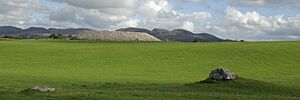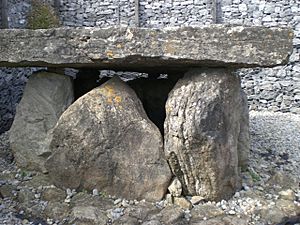Listoghil facts for kids
Listoghil (called Lios an tSeagail in Irish) is the biggest and most important monument among the ancient tombs at Carrowmore in County Sligo, Ireland. It's like the main building among many old burial sites. Experts called it 'Carrowmore 51' way back in 1837, and that name is still used today. Unlike some famous ancient places, Listoghil isn't directly linked to old Irish legends. It's the only cairn (a mound of stones) in the Carrowmore area.
Contents
What Does the Name Listoghil Mean?
The name Listoghil might mean 'Ryefort' in Irish. The word 'lios' usually means a court or an enclosed area. So, the name might have first described the whole area where the stone monuments stand, not just the stone mound itself.
Where is Listoghil Located?
Listoghil sits 59 meters (about 193 feet) above sea level. It's right in the middle of the Cúil Irra Peninsula, about 3 kilometers (less than 2 miles) from Sligo town. Because it's on a low ridge, it's like the main point of the Carrowmore passage tomb complex.
To the west, you can see Knocknarea mountain with Miosgán Médhbh (Queen Maeve's Cairn). To the east are two big stone mounds on Cairns Hill. Listoghil is surrounded by smaller stone circles, which are also passage tombs. These smaller tombs were open to the sky. Listoghil is much bigger than these, about 34 meters (111 feet) across. The smaller tombs are usually about 15 meters (49 feet) across. Queen Maeve's Cairn on Knocknarea is even bigger, twice the size of Listoghil.
How Listoghil Was Damaged and Discovered
In the 1880s, people were taking stones from Listoghil to build roads. They didn't know it was an important ancient site. The destruction stopped only when workers found a burial chamber in the middle of the mound.
By the late 1800s, experts called antiquarians started to study the tomb. They found things like horse bones, burnt wood, and a worked flint spearhead. Some items from Listoghil are now kept in the Alnwick Castle collection.
Excavation and Restoration of Listoghil
In the late 1990s, a Swedish archaeologist named Goran Burenhult partly dug up Listoghil. He used carbon dating to find the age of bones and other materials. He also uncovered the original stone edge (called a kerb) around the mound.
After this, the Office of Public Works helped restore the monument. Today, Listoghil is a 4-meter (13-foot) tall mound, 34 meters (111 feet) wide. You can go inside the central chamber through a 13-meter (42-foot) long pathway. The chamber itself is like a stone structure with six large standing stones (called orthostats). A single limestone slab, tilted a bit, forms the roof of the chamber.
You can see rare examples of megalithic art (ancient stone carvings) on the front of the roof slab. These are concentric circular carvings, which means circles inside other circles. You can only see them well in certain lighting. There's also a strange carving inside, described as a 'distorted tryfuss'.
Bones and other materials found at Listoghil were carbon dated to about 3500 BC. The human bones found were a mix of bones that had been burned (cremated) and those that hadn't. The older, smaller tombs around Listoghil usually only contain burnt bones. It seems a lot of burning happened in the area before the main chamber was built.
The Special Alignment of Listoghil
Listoghil points towards a low, saddle-shaped part of the Ballygawley Mountains. This spot is about 6.5 kilometers (4 miles) to the east-southeast. The sunrise in this exact position happens at the start and end of winter. These dates were very important seasonal festivals in the ancient Gaelic calendar.
In our modern calendar, these sunrises happen on October 31st and February 10th. These dates don't exactly match modern astronomical cross-quarter days. However, the way the sun shines into the chamber on these days is the same as another Neolithic passage tomb. This other tomb is the Mound of the Hostages at the heart of the Hill of Tara complex.



